 Regia Marina – Audace (ii) 1917-1944
Regia Marina – Audace (ii) 1917-1944WW2 Italian Destroyers
Poerio | Aquila | Mirabello | Leone | Sella | Sauro | Turbine | Navigatori | Freccia | Folgore | Maestrale | Oriani | Soldati | Medaglie d’OroWW2 Italian Torpedo Boats
Indomito | Audace | Audace(ii) | Pilo | Sirtori | La Masa | Generali | Palestro | Curtatone | Albatros | Spica | Pegaso | Ciclone | Ariete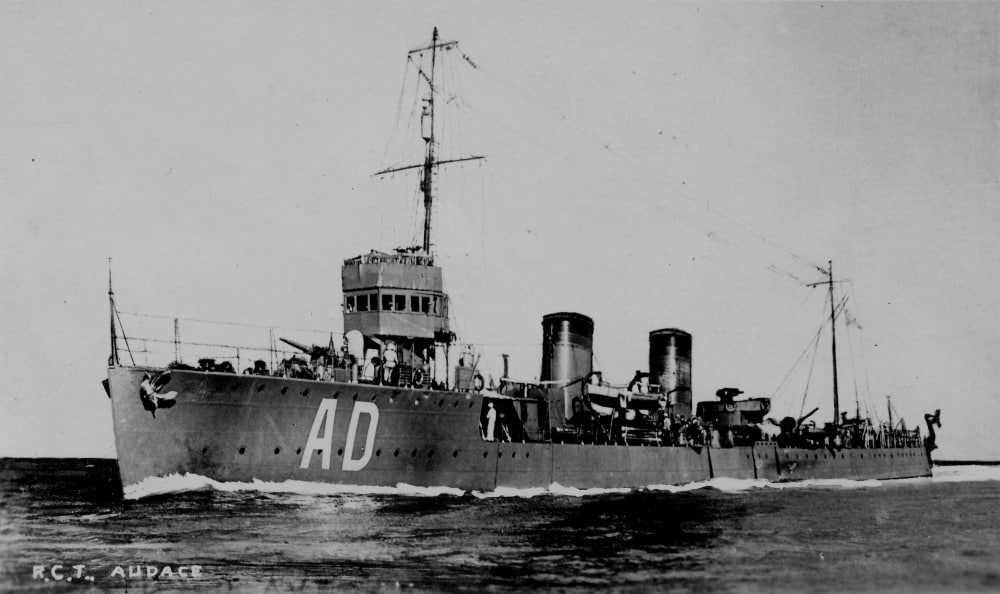
Audace is one of the most interesting destroyer of the Regia Marina for its long and original history. In WWI the Regia Marina fielded two destroyers named “Audace”. The first was launched in 1913 as a derivative of the Indomito & Ardito designs with Swiss Zoelly steam turbines for a change. Audace(i) started operations in 1915, ans sank in 1916 after a collision. A second of the same name was built, not in Italy but UK at Yarrow Scotstoun, and for the Japanese Navy (Urakaze class), for their participation in Mediterranean Operations.
After an agreement on 3 July 1916 between Japan and Italy, Kawakaze was transferred while still incomplete. On 5 July she was renamed Intrepido, and Audace on 25 September 1916, completed on 23 December 1916. She took part in the 1917-18 Adriatic campaign. In 1918 she was the first in Trieste. In the interwar she was active in the Aegean, Mediterranean, and Red sea, reclassified as torpedo boat in 1929, took part in the Spanish Civil War in 1937, became a command ship for the radio-controlled target ship San Marco, became a 1940 convoy escort, was captured By Germany after the armistice in 1943 as TA20, became a minelayer/escort in the Adriatic, and was eventually sunk by two British destroyers by late 1944.
Born in Japan, built in UK…
Japanese Destroyer experiments 1905-1916
In WWI the naval situation was very different from WW2 in that Italy in 1915 joined the entente, and Japan since the start of the war. Japan in 1914 was of course active in the Pacific, chasing after German possessions, islands like the Carolines, and the siege of Tsingtao forcing Von Spee and his Asiatic Battle Squadron to flee. See battle of Coronel and the Falklands, the Emden’s rampage… There was little to do left for the IJN afterwards. Thanks to the 1903 agreement with the United Kingdom, Japan was soon invited however to join Mediterranean Operations. There were interesting cases of destroyers constructions, like the French “Arabe” class destroyers built in Japan and conversely, British or Italian ships made or transferred to Japan for Mediterranean Operations.
Such was the case of the Urakaze class albeit they were ordered to UK before the war broke up. By then, the IJN was in full expansion and needed modern large destroyers to European standards. Indeed, Japanese yards had been busy building thirty-two Asakae class destroyers, essentially 380t glorified torpedo boats from 1905 to 1909, and its first two semi-experimental 1000t fleet destroyers, the Umikaze class designed with British assistance and powerplants in 1910. The Sakura, Kaba, Momo, Enoki, Isokaze and Tanikaze followed during WWI. But experience with steam turbines led to be desired in terms of range and in November 1912 two new destroyers with a ne type of mixed powerplant designed to for fuel economy were ordered to Britain. This was particularly acute due to the lack of Oil in mainland Japan, imported like Britain and large expanses of the pacific.
In 1911 already these experimental destroyers were planned, added to the current naval plan, but they were ordered two years later from the Yarrow Shipbuilders at Scotstoun (Scotland), eventually placing a contract for the first in 1913. IJN Kawakaze was thus laid down as “Destroyer No. 36” on 1 October 1913. Construction was however delayed by a backlog of orders, especially from 4 August 1914. The ship received the name Kawakaze (“Inlet Wind”) on 26 September 1914 and was to feature at first diesel engines for cruising.
This was to make her also the last destroyer built abroad for the Japanese Navy. Short cruising range indeed was a common problem for high-speed turbines which had a poor efficience at low power. She was to have had two cruising diesels, in analogy with modern CODOG diesel-gas turbine plants with two 22,000 shp Brown-Curtis turbines on 2 shafts, and two 1200bhp Burmeister & Wain diesels for cruising at 12kts. The diesels were to have been coupled to the main shafts through German-built Fottinger transformers, which could also reverse the propellers, as diesels could not run in reverse. The transformers were tried in Germany in July 1914, but could not be delivered due to the outbreak of war.
Transfer to Italy and completion

Indeed the reduction gear for that engine was to be manufactured by the German firm Furkan and now became unavailable. Meaning that she would be delivered with only steam turbine propulsion, making her less valuable to the Japanese. Instead at Yarrow, a temporary oil tank was fitted. Urakaze aside this became the first Japanese destroyer with 21-inches TT tubes, and first to be all oil-fired. Later on trials she made 30.26kts. One source suggests that her combined-plant concept was due, not to the Japanese Navy, but to Yarrow. As a unique unit, she was used for many years as a guard ship in China, rather than as a unit of a squadron.
Kawakaze, second ordered as part of the class was later delivered to Italy, a replacement being authorised under the 84 plan of 1917 so she was replaced by a unit of the Tanikaze class. Urakaze was eventually completed on 14 October 1915, not delivered to Japan until 1919, stricken in 1936 and hulked at Yokosuka in 1936, sunk there by US TF38 aircraft on 18 July 1945.
Foir her sister Kawakaze, fate was different: Italy entered the war on the side of the Allies in May 1915 and at the time, the Italians were desperately short of destroyers. The Italian attaché in Britain knew about the Sottish-built pair of destroyers now less desirable for Japan. Negotiations thus started with the Japanese to acquire Kawakaze. On 3 July 1916, Japan effectively sold Kawakaze to Italy and on 5 July 1916 the Italian Regia Marina named her “Intrepido” after the first one that sank after striking a mine in 1915. On 25 September she renamed her Audace after another which sank in a collision. All that happened as she was still in construction in Scotland. Audace was eventually launched on 27 September 1916, two days after her renaming, and she completed without her armament on 23 December 1916. The Italian intension was to have her completed to Italian standards if possible. Thus, she steamed to Naples, reached on 9 January 1917 with her armament installed there, and many other modifications until she was commissioned at last on 1st March 1917. Her identification letters were “AD”, painted on her forecastle.
Design of the class

At almost 90 meters long for 1170 tonnes deeply loaded she was at the time, the largest Italian destroyer ever commissioned. There were larger flotilla leaders, but they were considered as cruisers. Her powerplant was “classic” and that was the source of her selling by Japan which counted on the initial mixed diesel-steam plant to experiment solutions to gain extra range. This was no longer a problem in the confines of the Adriatic. She was a very peculiar ship with a short forecastle, almost 1/5 of her lenght, two funnels far apart, with the forefunnel far behind the forecastle and bridge, a tall foremast and short aft mast, an enclosed bridge with open one above plus single searchlight on platform, six main guns, two duel purpose ones and twin 21-inches torpedo tubes, which was new in the Regia Marina. Her almosty straight bow had little flare. She had a sloped down rounded bow cut straight below the waterline, and rounded rudder, two shafts.
Hull and general design
Audace between perpendiculars leasured 83.9 meters (275 ft 3 in), with an overall length of 87.59 meters (287 ft 4 in) and a beam of 8.38 meters (27 ft 6 in) for a 1/10 ratio, draft of 2.5 meters (8 ft 2 in). As completed she displaced more than her sister ship Urakaze at 922 metric tons (907 long tons) at normal load and 1,170 metric tons (1,150 long tons)t deeply loaded, plus a complement of five officers and 113 enlisted men. Audace is one of the best known Italian destroyer of that era, with many reconstructions made.
Powerplant
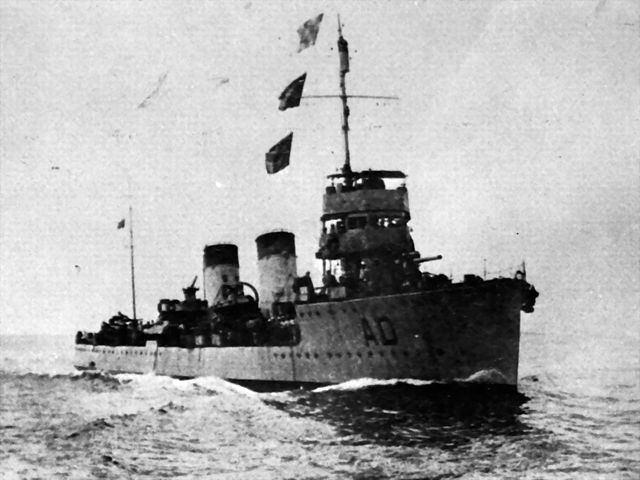
Audace came out with a classic powerplant of two Brown-Curtis steam turbines driving their own propeller shaft with the steam supplied by three Yarrow boilers. Maximum output was 22,000 shaft horsepower (16,405 kW), top speed was 30 knots (56 km/h; 35 mph) as contracted at Yarrow but she handily exceeded this figures, making 34.5 knots (63.9 km/h; 39.7 mph) in her Naples sea trialson the usual light load. Cruising range was still 2,180 nautical miles (4,040 km; 2,510 mi) at a speed of 15 knots (28 km/h; 17 mph). To compared this was 1,200 nmi (2,200 km; 1,400 mi) at 14 knots (26 km/h; 16 mph) on the former Intrpido, and 560 nautical miles (1,000 km; 640 mi) at a speed of 30 knots (56 km/h; 35 mph) versus 500 nmi (930 km; 580 mi) at 25 knots (46 km/h; 29 mph).
They were in short, the better performers of the Italian Navy.
Armament
Although often said “unarmed” when she sailed for Italy, it was not true. She departed with two quick-firing (QF) 39-caliber two-pounder anti-aircraft guns, installed Japan sold her to Italy, placed amidship aft, close to the aft mast on either side. These fired the classic Vickers 40-millimeter (1.6 in), 0.91-kilogram (2 lb) high-explosive shells to down aircraft, at a muzzle velocity of 620 meters per second (2,040 ft/s).
The Regia Marina reworked her armament upon arrival and chosed at first, perhaps motivated by her long hull, to fit as much as seven QF Cannon 76/40 Modello 1916, all single. The latter fired a 13.75-kilogram (30.31 lb) shell at 2,480 feet per second (755 m/s). The initial 21-inchesd tibes were never fitted and instead she received four 450-millimeter (17.7 in) torpedo tubes in twin mounts on each broadside.
76mm/40 (3 inches) M1916 Ansaldo
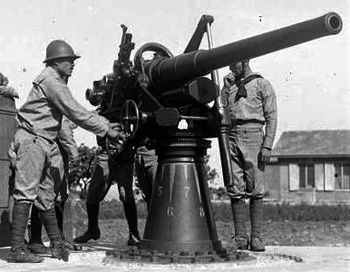 The Cannone da 76/40 originated in the British QF 12-pounder 12 cwt naval gun designed back in 1893, first produced in 1897. The QF 12-pounder 12 cwt gun from Elswick Ordnance was distributed to the Royal Navy and export. Italy and Japan were were two early export customers, purchased production licenses. Most Italian one were produced by Ansaldo from a design provided during World War I by Armstrong, parent company of EOC.
The Cannone da 76/40 originated in the British QF 12-pounder 12 cwt naval gun designed back in 1893, first produced in 1897. The QF 12-pounder 12 cwt gun from Elswick Ordnance was distributed to the Royal Navy and export. Italy and Japan were were two early export customers, purchased production licenses. Most Italian one were produced by Ansaldo from a design provided during World War I by Armstrong, parent company of EOC.
Mass: 510 kg (1,120 lb)
Dimensions: 3.13 m (10 ft 3 in) oa, barrel 3 m (9 ft 10 in), 40 caliber
Crew: 7
Shell: Fixed 5.6–6.5 kg (12–14 lb) QF 76.2 x 420mm R
Elevation/traverse: -6° to +81°, 360°
Rate of fire: 12-15 rpm
Muzzle velocity: 680 m/s (2,200 ft/s)
Effective range: 10.7 km (6.6 mi) at +40°, 5.8 km (19,000 ft) at +70°, 4.8 km (16,000 ft) AA ceiling.
QF 2-pounder/39 anti-aircraft guns
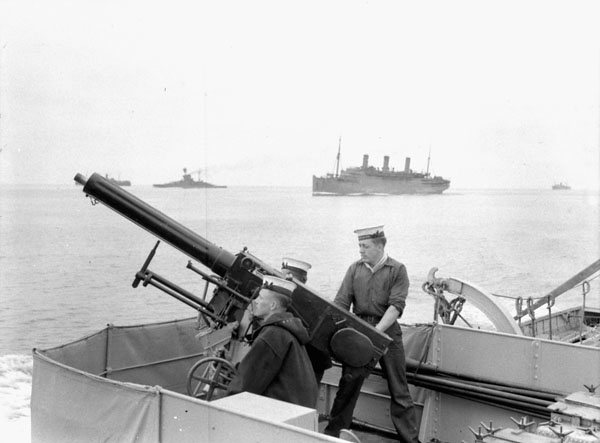
The two original barrels were installed abaft the aft mast, one on each side.
Mass 385,5 kg, barrel 2,61 m/40 mm.
Shell: 980 g, mv 732 m/s, 115 rpm
Max Range 4.572 m
Torpedo Tubes and ASW
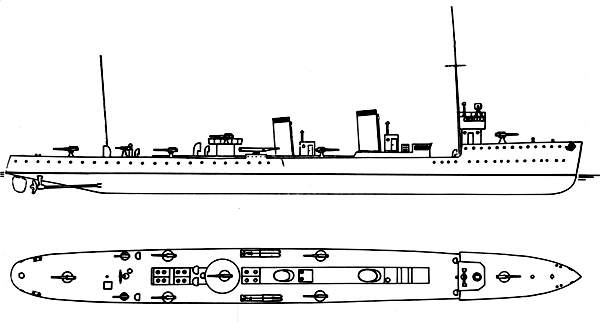
The 17.7 inches torpedo tubes (450 mm) used at the time were Thornycroft models built in Italy by Silurificio Italiano. They were launched from two twin tubes on either side,
In addition to the two twin torpedoes tubes, Audace was completed with two racks for 8 depth charges total and one paravane as anti-mine, ASW weapon.

⚙ specifications |
|
| Displacement | 922 t (907 long tons) |
| Dimensions | 87.59 x 8.38 x 2.5 m (287 ft 4 in x 27 ft 6 in x 8 ft 2 in) |
| Propulsion | 2 shafts steam turbines, 3 Yarrow boilers 22,000 shp (16,405 kW) |
| Speed | 30 knots (56 km/h; 35 mph) |
| Range | 2,180 nmi (4,040 km; 2,510 mi) at 15 knots (28 km/h; 17 mph) |
| Armament | 7× 102 mm (4 in), 2× 40 mm (1.6 in) AA guns, 2×2 450 mm (17.7 in) TTs |
| Crew | 5 officers, 113 enlisted men |
Career of Audace (ii)
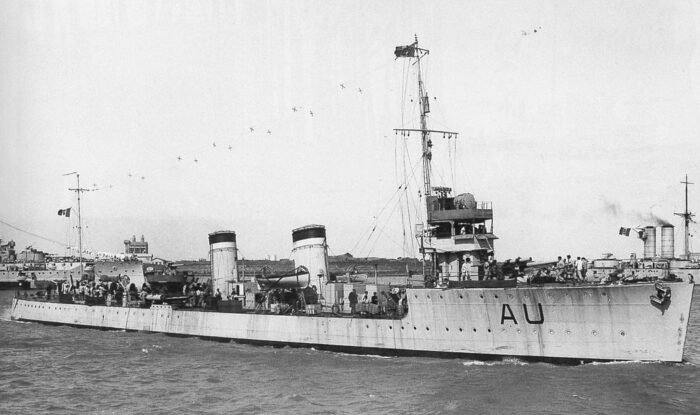
Audace proceeded from Naples in March 1917 to Brindisi, escorting the submarines H1 and H2, underway, both Canadian built, from Messina to Taranto. Next she was posted in the upper Adriatic Sea and on 11 May 1917 saw her first operation from Venice with Animoso, Ardente, Ardito, and Giuseppe Cesare Abba interception of the DD Csikós and TBs 78 T, 93 T, and 96 T. Spotted at 15:30 from 10,000 meters (10,900 yd) but were unable to engage them as they entered a minefield off Pola.
On the night of 13–14 August 1917 she sortied again with many destroyers to intercept the DDs Dinara, Reka, Sharfschutze, Streiter, and Velebit plus six torpedo boats after an air raid over Venice, killing 14, injuring 30 others. Only Orsini managed to make had contact but lost them.
On 29 September she became flagship under Capitano di fregata Arturo Ciano, future admiral alongside side DDs and the flotilla leader Sparviero to support a raid of 10 Italian airplanes against Pola. They briefly exchanged fire with Streiter, Velebit, Huszar and Turul.
On 16 November Audace she sortied with the same after a bombardment by the coastal defense ships Wien and Budapest off Cortellazzo. They were supported by MAS 13 and MAS 15 which, aircraft and the submarines F11 and F13. The Austrians withdrew.
On 18 November with three DDs she shelled Austrian-Hungarian linesbetween Caorle and Revedoli.
On the 28th she stortied to intercept a force of destroyers and TBs attaciking the Italian coast, Porto Corsini and Rimini, but they were unable to enagaged them (only aicrafft did) whe they arrived near Cape Promontore, too close to Pola. 10 February 1918, Audace and two other DDs departed Venic for the raid on Bakar (Buccari) while Aquila, Ardente and four others stood by at Porto Levante in supprt. Audace towed the motor torpedo boat MAS 94 20 nautical miles (37 km; 23 mi) east of Sansego, passing the tow cables to the coastal TB 12 PN to complete the last 50 nautical miles (93 km; 58 mi) leg off Ancona. The MAS damaged just a steamer. This became back home the “Beffa di Buccari”.
The night of 1–2 July 1918 saw Audace, with four more and two in distant support in another raid with 8 coastal torpedo boats, some towing dummy landing pontoons as a mock amphibious landing while TBs shelled lined between Cortellazzo and Caorle. Balaton and Csikós sallied out with two TBs late on the evening of 1 July. On MAS nearrowly missed SMS Balaton at noon on 2 July. Chas started at 03:10. Balaton was the most damaged, Audace, La Masa, and Missori concentrated next on Csikós and the two TBs. Csikós was hit in her aft boiler room but she withdrew toward Pola, while Italian torpedo boats resume operations.
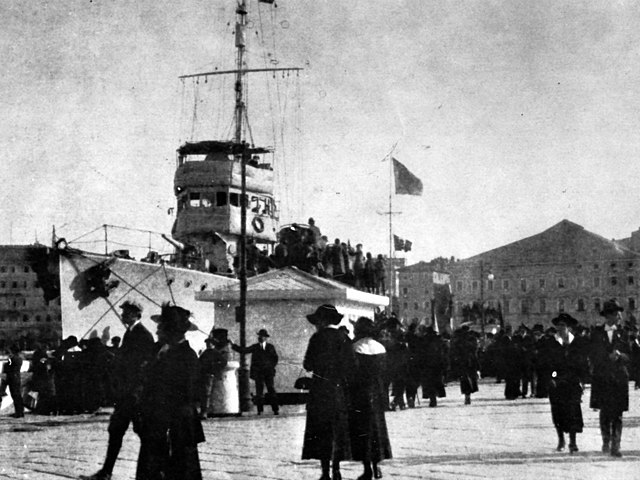
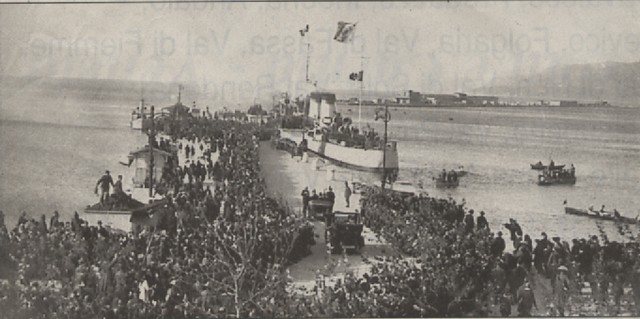
Audace at Trieste in November 1918. The San Marco Pier was renamed Molo Audace (Audace Pier) in her honor.
After the Armistice of Villa Giusti (3 November 1918), Audace played a leading role. On 3 November, she sailed from Venice with La Masa, Missori, Fabrizi to meet Climene and Procione from Cortellazzo. They proceeded to Trieste for its occupation, arriving at 16:10. 200 Carabinieri were landed under General Carlo Petitti di Roreto, proclaiming the annexation.
On 7 November 1918, Audace escorted by 16 OS and 68 PN, entered Zadar (Zara) and landed a patry to seize the city and eliver supplies to the local population. She arrived next on 10 November in Trieste with the King of Italy Victor Emmanuel III, Generals Armando Diaz and Pietro Badoglio. The ceasefire was effective on 11 November.
By mid-November 1918, she entered Pola with HMS Dartmouth and on the 17th transported US soldiers to Fiume to completed the entente occupation, later completed by the Italian Royal Army and Royal Serbian Army troops.
On 23 December 1918 she assisted the mined British merchant ship Queen Elizabeth off Šibenik.
On 24 March 1919 she carried King Victor Emmanuel III, MoN Alberto del Bobo, Deputies president Giuseppe Marcora when former Austro-Hungarian Navy ships were ceded to Italy as war reparations, escorted from Pola to Venice.
From September 1920 to June 1921, Audace was assigned to the Levant Division in Smyrna, Aegean coast, then transferred to Šibenik (Sebenico). She had an overhaul at Taranto after which she retutrned on station at Heraklion (Candia), Crete. From January to April 1923 she was under orders of the governor of Italian Tripolitania, in Tripoli. From August 1923 she sailed to Tangier with a marshal and 12 Carabinieri after an incident involving Italian citizens and the police. From 1923 to 1928 she became flagship of the Department of Taranto, crusing in the Italian Dodecanese an Aegean, with TBs.
She entered the Special Division and reserve, reclassified as TB on 1 October 1929, and moved to northern Adriatic, and then back to Tripoli, the Red Sea (Naval Division). During the Spanish Civil War from 1937 she was sent to support the Nationalists, and was found at Cádiz and Tangier. Later back home she was modified as command ship for the radio-controlle armoured cruiser San Marco for tests in the northern Tyrrhenian Sea until 1940.
After Italy declared war on France on 10 June 1940, Audace was at La Spezia. Her main armament was reduced to three 4-inch guns and she was very much seen as outdated. She stuck to ASW patrols and convoy escort and then in 1941 consisted, training at the Gunnery School and Submarine Schoo in Pola. In 1942 and 1943 she escorted convoys in the uncontested Adriatic Sea. In 1943 she lost one main gun and two 2-pdr QF AA guns for five Breda 20 mm (0.79 in)/65 Modello 35 in single mounts.
On 8 September 1943, the armistice intervened and she was captured by force as part of Operation Achse. Under Italian flag her crew decided to leave Trieste on 9 September to Venice, and southern Ital to join the allies but Engine problems forced her back to Venice, where she fell under German hands on 12 September.
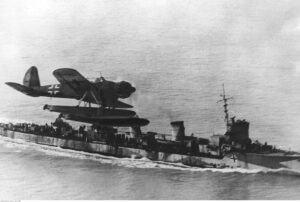 For her last carrer in the Kriegsmarine as TA20, anti-aircraft armament wa smassively ramped up, with 20 Breda guns in ten twin mounts. Her role remained escort, but also anti-partisan raod and police operations, as well as minelaying in the Adriatic. She laid a minefied south of Ancona on 15 March 1944, then Porto San Giorgio and destroyed liquor factories in Šibenik and Zadar.
For her last carrer in the Kriegsmarine as TA20, anti-aircraft armament wa smassively ramped up, with 20 Breda guns in ten twin mounts. Her role remained escort, but also anti-partisan raod and police operations, as well as minelaying in the Adriatic. She laid a minefied south of Ancona on 15 March 1944, then Porto San Giorgio and destroyed liquor factories in Šibenik and Zadar.
On 1 November 1944, TA20 and UJ 202, UJ 208 departed Zadar to transport troops to Rab, Dalmatia. At 19:50 HMS Avon Vale and Wheatland sighted UJ 202 and UJ 208 off Pag and attacked at 20:10 from 3,600 metres (3,900 yd), quickly overwhelming them. Avon Vale rescued survivors of UJ 208 when TA20 intervened, surprising them, all guns blasting and torpedoes at the ready. The two destroyers after the schock changed course, and quickly founf their mark on TA20. Her bridge was hut, she lost all her officers and captain in there, and her engine room. She could not withdraw, and her crew abandoned ship. She sank south of Lošinj (Lussino) with the british destroyers rescuing 71 members of her crew, later a German ship rescued 20 more.
TA20′s wreck was identified by Leonardo Laneve and Mario Arena in 1999, off Pag under 80 metres (262 ft).
In May 2015, an Italian diving group started “Audace Project” and the “Audace Expedition” by late 2015, leding to many photographs and videos, the then “Audace Event” on 7 May 2016. The movie was presented at the G. Modena theater in Palmanova, Italy.
Read More/Src
Links
agenziabozzo.it cacciatorpediniere_audace
en.wikipedia.org/ Italian_destroyer_Audace (1916)
nauticamare.it spedizione-audace-2009.html
navypedia.org/ it_dd_audace.htm
Videos
Model Kits
larsenal.com 1-700 audace-1942
modelshipgallery.com/ Audace-1/350
on modellismopiu.it

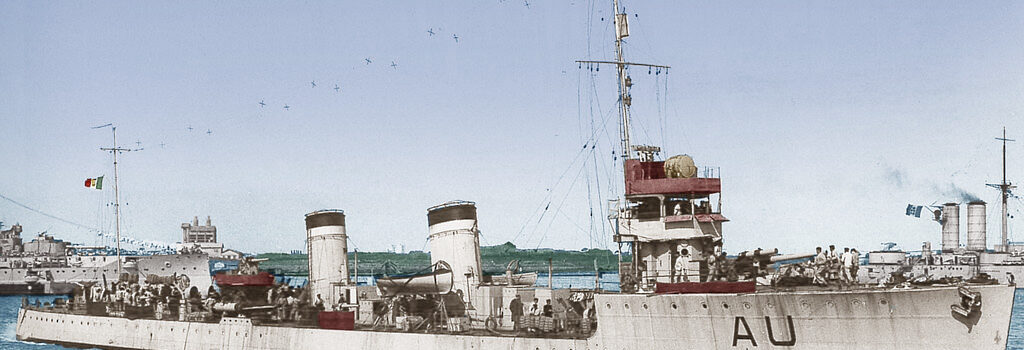
 Latest Facebook Entry -
Latest Facebook Entry -  X(Tweeter) Naval Encyclopedia's deck archive
X(Tweeter) Naval Encyclopedia's deck archive Instagram (@navalencyc)
Instagram (@navalencyc)





 French Navy
French Navy Royal Navy
Royal Navy Russian Navy
Russian Navy Armada Espanola
Armada Espanola Austrian Navy
Austrian Navy K.u.K. Kriegsmarine
K.u.K. Kriegsmarine Dansk Marine
Dansk Marine Nautiko Hellenon
Nautiko Hellenon Koninklije Marine 1870
Koninklije Marine 1870 Marinha do Brasil
Marinha do Brasil Osmanlı Donanması
Osmanlı Donanması Marina Do Peru
Marina Do Peru Marinha do Portugal
Marinha do Portugal Regia Marina 1870
Regia Marina 1870 Nihhon Kaigun 1870
Nihhon Kaigun 1870 Preußische Marine 1870
Preußische Marine 1870 Russkiy Flot 1870
Russkiy Flot 1870 Svenska marinen
Svenska marinen Søværnet
Søværnet Union Navy
Union Navy Confederate Navy
Confederate Navy Armada de Argentina
Armada de Argentina Imperial Chinese Navy
Imperial Chinese Navy Marinha do Portugal
Marinha do Portugal Mexico
Mexico Kaiserliche Marine
Kaiserliche Marine 1898 US Navy
1898 US Navy Sovietskiy Flot
Sovietskiy Flot Royal Canadian Navy
Royal Canadian Navy Royal Australian Navy
Royal Australian Navy RNZN Fleet
RNZN Fleet Chinese Navy 1937
Chinese Navy 1937 Kriegsmarine
Kriegsmarine Chilean Navy
Chilean Navy Danish Navy
Danish Navy Finnish Navy
Finnish Navy Hellenic Navy
Hellenic Navy Polish Navy
Polish Navy Romanian Navy
Romanian Navy Turkish Navy
Turkish Navy Royal Yugoslav Navy
Royal Yugoslav Navy Royal Thai Navy
Royal Thai Navy Minor Navies
Minor Navies Albania
Albania Austria
Austria Belgium
Belgium Columbia
Columbia Costa Rica
Costa Rica Cuba
Cuba Czechoslovakia
Czechoslovakia Dominican Republic
Dominican Republic Haiti
Haiti Hungary
Hungary Honduras
Honduras Estonia
Estonia Iceland
Iceland Eire
Eire Equador
Equador Iran
Iran Iraq
Iraq Latvia
Latvia Liberia
Liberia Lithuania
Lithuania Mandchukuo
Mandchukuo Morocco
Morocco Nicaragua
Nicaragua Persia
Persia San Salvador
San Salvador Sarawak
Sarawak Uruguay
Uruguay Venezuela
Venezuela Zanzibar
Zanzibar Warsaw Pact Navies
Warsaw Pact Navies Bulgaria
Bulgaria Hungary
Hungary

 Bundesmarine
Bundesmarine Dutch Navy
Dutch Navy Hellenic Navy
Hellenic Navy Marina Militare
Marina Militare Yugoslav Navy
Yugoslav Navy Chinese Navy
Chinese Navy Indian Navy
Indian Navy Indonesian Navy
Indonesian Navy JMSDF
JMSDF North Korean Navy
North Korean Navy Pakistani Navy
Pakistani Navy Philippines Navy
Philippines Navy ROKN
ROKN Rep. of Singapore Navy
Rep. of Singapore Navy Taiwanese Navy
Taiwanese Navy IDF Navy
IDF Navy Saudi Navy
Saudi Navy Royal New Zealand Navy
Royal New Zealand Navy Egyptian Navy
Egyptian Navy South African Navy
South African Navy






























 Ukrainian Navy
Ukrainian Navy dbodesign
dbodesign